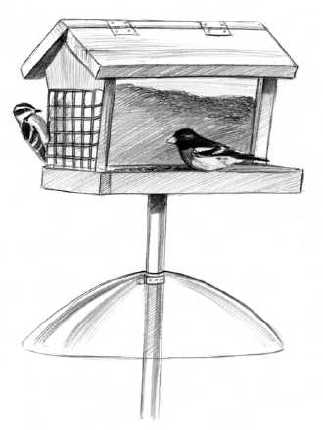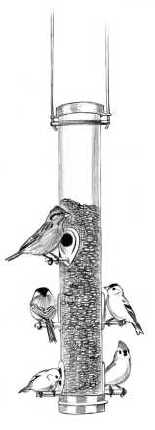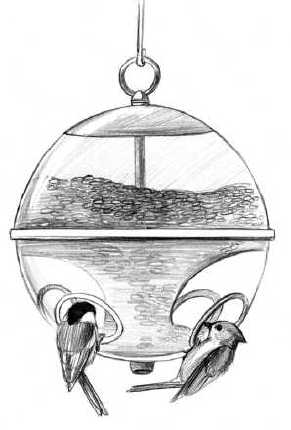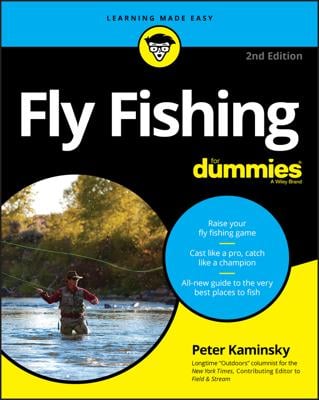Shiny, clanky, commercially available bird feeders have a lot going for them. First and foremost, they keep the seed fresh and dry. It can be snowing like mad, covering up your bird table and ground feeding area in seconds, and a good hanging feeder will still be calmly dispensing seed to the hungry.
Commercial feeders come in three basic types: hopper, tube, and satellite.
Hoppers (not Dennis)
Hopper feeders have a lot of different styles, but the old favorite looks like a little barn or covered bridge, minus the young lovers and graffiti. The sides are usually panels of clear acrylic that allow you to see how much seed remains, and access is usually through the top (see Figure 1).
 |
Figure 1: Hopper feeders are old favorites. A downy woodpecker (left) and a male rose-breasted grosbeak are at this one. |
A good hopper feeder can be disassembled for cleaning. Hoppers can be pole-mounted, often with a threaded sleeve that screws onto the threaded top of a plumber's galvanized pipe. They can be suspended, too.
The two best features of hoppers are the following:
- They hold a lot of seed, so that you don't have to go out every day to refill them.
- They're big and bird-friendly. Shy birds, or big birds like doves and jays and woodpeckers, are able to land and feed from them comfortably.
When unusual species such as rose-breasted grosbeaks show up at a feeder, they'll usually come to hopper feeders. Birds that are reluctant to perch on tube feeders or cling to satellite feeders will happily come to a hopper feeder.
You can feed any kind of seed in a hopper feeder because the seed usually comes out of slots at the bottom of the acrylic panels. Sunflower seed is a favorite of many hopper feeder visitors, but seed mixes containing millet, corn, and peanut hearts can be fed in these feeders, too.
Totally tubular
Tube feeders — long cylinders with perches at the feeding ports — are the classic feeders for woodland birds like chickadees, titmice, woodpeckers, and nuthatches, as well as for finches like goldfinches, siskins, and house finches. All these birds are small, and they can hang out comfortably on the usually short metal perches most tube feeders have (see Figure 2).
 |
Figure 2: Small, seed-eating birds, such as finches and chickadees, like tube feeders. |
Tube feeders are great for screening out big birds like blue jays, grackles, blackbirds, and doves, if you're into avian discrimination. But they also keep grosbeaks and cardinals away, too, because these birds aren't so good at clinging, and they're just too big for the perches. They'll go to the hopper or platform feeders, or onto the ground.
When you're looking at tube feeders, make sure the seed you're planning to put in them will fit through the holes at the feeding ports. Most have big holes that let sunflower seed through, but others are made especially for the tiny thistle or niger seed.
Satellites (going global)
Speaking of tiny, if you want to cater only to little birds like chickadees, titmice, nuthatches, goldfinches, and siskins, then pick a globe feeder. These look like flying saucers, or satellites, and they're suspended from a wire so that they spin when a bird lands on them (see Figure 3). Dizzying, but no problem for all these little clinging birds.
 |
Figure 3: Clinging birds can hang from a globe feeder. |
If you're sick of shoveling feed into the maws of flocks of house finches, try a satellite feeder. Birds must approach them from the bottom and cling upside-down to feed from them. But you fill them with seed from a small, capped opening in the top. Some satellite feeders have a domed baffle on top to keep squirrels out, too. House finches just can't do the cling thing; their legs aren't strong enough.
So if you see your chickadees politely trying to fit in edgewise among the house finches at the tube feeder, hang a satellite feeder just for them.
What to look for when buying
Many feeder styles are on the market, but any feeder you buy should be easily filled, emptied, and cleaned.
- Beware of feeders that require you to use a funnel to fill them because you'll quickly tire of lugging a funnel out every time you have to replenish the seed.
- Wooden parts of hopper feeders should be made of weather-resistant cedar, or stained or painted to protect against moisture. Plastic feeders should be reinforced with metal around the feeding ports to ward off chewing squirrels. Perches should be metal or replaceable dowel, for the same squirrelly reasons.
- Because you may be looking at a feeder for a decade or more, it pays to buy the sturdiest and most easily maintained one you can.
- With tube feeders, look at the bottom port. Is there dead space beneath it where seed can collect because the birds can't reach it? This seed gets all icky and moldy — a waste of food, and dangerous for the birds.
- Can you take the feeder apart to scrub and clean it? If it looks like you'll need fancy bottle brushes or an act of Congress to get it clean, pick one of simpler design.
- Beware of super-cheap feeders. Not all of the $5 to $10 feeders available for sale are going to last you for more than one season of feeding. Remember, these things are going to be filled with seed and hung out in the weather. Look for durable construction if you want to get your money's worth.
By now, a picture should be emerging of an ideal feeding station — one with a variety of different feeder styles, at different heights, where the greatest diversity of birds can find food. It should provide shelter from wind, rain, and predators in the form of shrubbery or the instant habitat of brushpiles and found materials. It should have a wide variety of foods, and some water should be available year-round.

